Haswell and GK110 vs. Ivy and GK104: DigitalStorm Virtue System Review
by Dustin Sklavos on June 23, 2013 12:00 PM ESTSystem and Gaming Performance
The two subjects we want to examine with the DigitalStorm Virtue and its 4.4GHz Intel Core i7-4770K are whether or not the overclocking plateau really has stayed level over the past two or three generations of Intel CPUs, and just how close GK104 can really get to GK110. Remember that the GeForce GTX 770 actually ships with memory clocks higher than most GTX 680s could attain, and memory bandwidth was frequently the bottleneck with GK104.
An important comparison to keep in mind: the 4.6GHz Intel Core i7-3770K is only clocked about 5% faster than the new 4.4GHz i7-4770K. Haswell tends to be roughly 10% faster clock per clock than Ivy, so with some dirty math it would take about a 4.8GHz i7-3770K to make up the performance gap.
As for the overclocked GTX 680 against the GTX 780, that's a bit trickier. The 780 is working with almost 50% more memory bandwidth, and with some extremely dirty math, about 20% more shader power. That's before you try to calculate the GTX 780's boost clocks, which are much jumpier than the GTX 680's. Even missing an entire SMX cluster, GK110 is still a bear compared to the more svelte GK104.
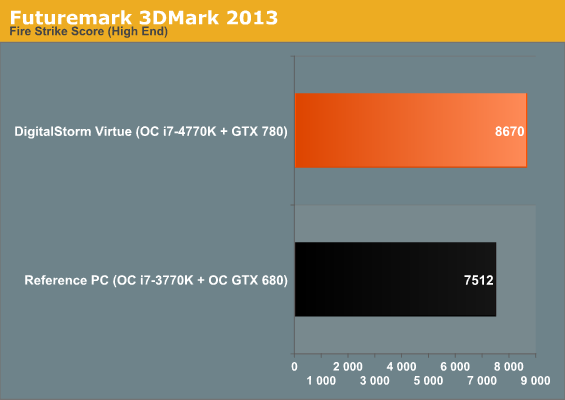
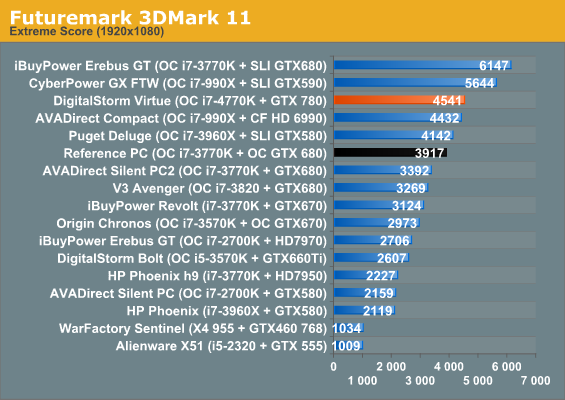
The 3DMarks pretty much tell the story. In both 3DMarks, a stock 780 is still ~15% faster than a heavily overclocked GTX 680.
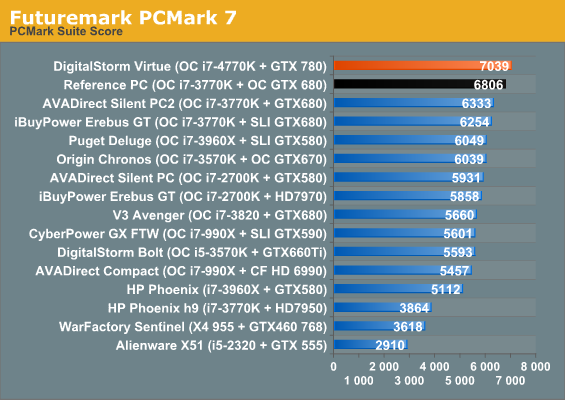
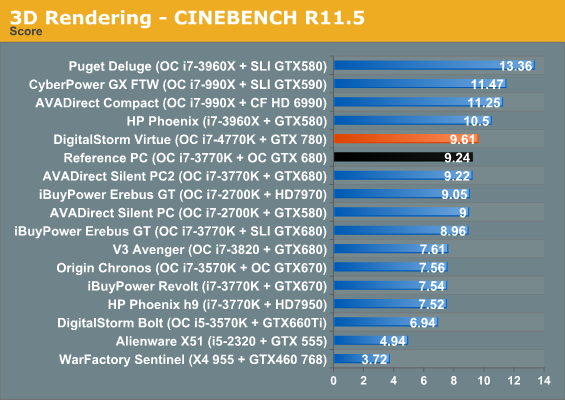
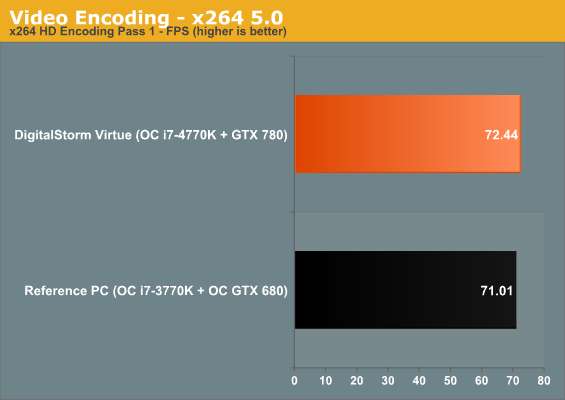
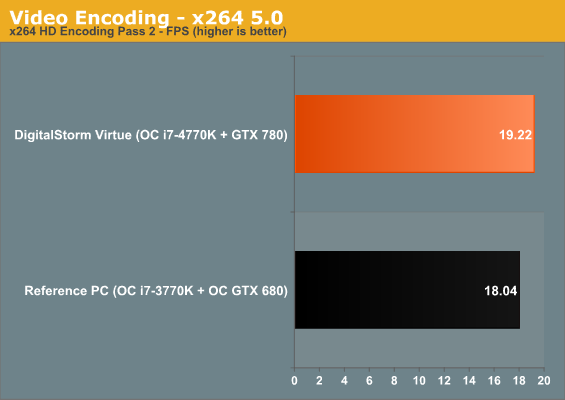
While PCMark7 tends to simply favor newer, faster SSDs, the difference between Haswell and Ivy gets a lot uglier when we isolate CPU performance. Consensus is that we've lost a bit of overclocking headroom with Haswell, making the comparison between a 4.6GHz Ivy and 4.4GHz Haswell a reasonably fair one. Cinebench is just 5% faster on Haswell, the first pass of the x264 benchmark is a dismal 2% faster on Haswell, and the second pass is at least a slightly healthier 7%.
Also note the improvement from Sandy to Ivy in Cinebench, though: our fastest Ivy is just 2% faster than our fastest Sandy. That Sandy was also running at 4.6GHz. Ivy at least brought a fat reduction in power consumption and TDP from Sandy despite the mediocre IPC improvement, but Haswell actually increased power consumption.
The math gets even uglier when we compare Sandy to Haswell. A 4.4GHz i7-4770K is only 6% faster than a 4.6GHz i7-2700K. That means that in two subsequent generations, the performance ceiling has barely moved. Anand is keen to point out that Intel's ability to eke out ~10% additional IPC on the same 22nm process node with a new architecture is impressive, and that may be true from a technical perspective, but Intel has offered enthusiasts virtually nothing new for two generations running. So whether or not the technical achievement is notable, end users are still left holding the bag. At this point, if you're hankering for more performance on the CPU, your best bet is actually to either go for an i7-3930K or wait for Ivy Bridge-E and hope Intel doesn't bone us with thermal paste instead of fluxless solder again. The only real selling point of Haswell, as far as I'm concerned, is access to the Z87 chipset.
Thankfully, while the jump in price from the NVIDIA GeForce GTX 680 to the GTX 780 isn't a particularly happy one, at least that dial moved pretty substantially. We tested every game at our Enthusiast settings (essentially maxed out and topping out at 4xMSAA), at 1920x1080 and then at 5760x1080.
|
GTX 680 1080p |
GTX 780 1080p |
% Perf. Increase |
GTX 680 Surround |
GTX 780 Surround |
% Perf. Increase |
|
| BioShock Infinite | 83.1 | 91.6 | 10.2% | 32.5 | 37.1 | 14.2% |
| Elder Scrolls V: Skyrim | 93.4 | 104.1 | 11.5% | 72.1 | 75.7 | 5% |
| GRID 2 | 87.3 | 109.2 | 25.1% | 39.4 | 49.2 | 24.9% |
| Metro: Last Light | 36.7 | 40.7 | 10.9% | 13.7 | 15.7 | 14.6% |
| Sleeping Dogs | 90 | 101.2 | 12.4% | |||
| StarCraft II: Heart of the Swarm | 73.5 | 86.2 | 17.3% | |||
| Tomb Raider | 64.3 | 72.5 | 12.8% | 31.8 | 36.5 | 14.8% |
So how do we interpret these results? First, excluding the outlying Skyrim surround results, even a diehard overclocked GTX 680 user can expect to net at least 10% more power from the GTX 780. Bumping up to 5760x1080 actually even lets the GTX 780 start to stretch its legs; while the 680 seems to be limited either by memory capacity or memory bandwidth, the 780's 384-bit memory bus and extra 1GB of GDDR5 do a solid job of picking up the slack.
Remember, too, that this is all before you overclock the 780. The consensus right now seems to be that the 780 has a very healthy amount of overclocking headroom, more than the 680 did, so if you're willing to sacrifice some power consumption and noise, you can theoretically push the 780 to Titan levels and even a bit beyond. At that point, it will pull away substantially from the 680 and by extension, the 770. I'm planning to do a custom liquid cooling review in the near future to get a grasp of just how far we can reasonably push a pair of GTX 780s, and given that I regularly see boost clocks of about 1GHz on them with just air cooling and no overclocking, I'm pretty optimistic.










70 Comments
View All Comments
techienate - Wednesday, July 10, 2013 - link
No, a system warranty is worth more than individual component warranties. One example: Let's say you have a potential CPU OR motherboard problem causing occasional bluescreens or crashes, but you don't know for sure which it is. Do you have the spare parts to swap out the cpu and motherboard one at a time to determine what the problem is? Not unless you spend more money. Also, it can take considerable time to diagnose these hardware issues, and time is money. If you don't think it's worth $200 dollars, then don't buy it. But saying it only costs them $20 proves you know nothing about how much it costs to run a business. If it were my own computer, I would build it myself. But if someone offered to pay me $200 to build it for them (I am an IT professional and get requests for help all the time), I wouldn't do it. It wouldn't be worth the hassle, time, and risks. So in that way, I think the $200 is a totally reasonable premium.iamezza - Monday, June 24, 2013 - link
It's always the same comment whenever a boutique is reviewed.They are offering a service for a certain price and people who want that service pay for it, simple.
It's true most people with half a brain could assemble a computer themselves if they learnt, most people don't have the time or desire how to do it themselves.
If I wanted to to I could do all the work on my own car, but personally I prefer to pay a mechanic to do it for me.
Sometimes it's just easier to pay someone, especially if you could earn more money doing your own job then you would otherwise save by doing it yourself.
JimmiG - Monday, June 24, 2013 - link
It took my just about one full weekend (Friday evening to Sunday night) to build and initially get my latest system running the way I liked, finding a good 24/7 overclock, finding the tightest memory timings that would work etc. and several more weeks until everything was running exactly how I liked it software- and hardware-wise.Since I actually enjoy that process, the time was worth it for me. However not everyone has that kind of time or enjoy building and tweaking computers. Time is money - If your regular job pays more than $200 for working a full weekend, you would actually save money by paying someone else $200 to build a computer for you.
JBVertexx - Monday, June 24, 2013 - link
Here's the value... For a guy, say a CPA, who makes a decent amount of money. He's into tech, but not at an "enthusiast level". He hires a lanscaping company to mow his lawn, a financial advisor to manage his money, another CPA to do his taxes, and he's willing to hire experts to build a top-end PC.Maybe this guy likes to game. Maybe he just wants an awesome PC for his kid. But he's definitely not going to waste time learning all the in's and out's of motherboard/cpu/case compatibility, power requirements, GPU performance, cooling, and all that.
He also wants something better than what most other people have. He likes to buy from boutique firms in general. He just got a nice $50k bonus, and he has no problem dropping $2.5k on a high-end PC.
Rvenger - Sunday, June 23, 2013 - link
Dustin, any chance you can run some IBT AVX on that Haswell and report your highest core temps? I noticed the high vcore and am wondering if the same binned CPUs are being used as the retail box ones we buy at newegg etc. According to that vcore, that CPU should thermal throttle within minutes when Prime95 small fft or IBT with AVX is ran.BrightCandle - Monday, June 24, 2013 - link
You wont see much benefit running a 680 under a custom water block. It might in theory go slightly faster but its not normally much. In order to get at the extra performance potential you need to pump more voltage through the chip than an air cooler could cope with, and that level of voltage adjustment is not all that easy with todays GPUs, and the gains are often quite marginal even then.I typically say that a custom loop is worth about 5% at most. On a CPU its maybe 100-200Mhz as long as your willing to push more voltage (which could kill the chip regardless of the reduced temperature). On the GPU side I have typically only found water to offer around 25Mhz, its normally not much at all. Its real advantage is noise reduction.
wumpus - Monday, June 24, 2013 - link
Odd. I'd expect a bit more. Even then you can certainly expect more quiet than you will get with airflow. From the comments in the article, the 780 may be a far better board for trying out water cooling.7Enigma - Monday, June 24, 2013 - link
Ouch, harsh but true. Let's hope he didn't have his coffee yet and we can pretend to let it slide.7Enigma - Monday, June 24, 2013 - link
I have a more sinister thought that it had nothing to do with cost and everything to do with artificially limiting the performance of the chips. They are so far beyond AMD right now on almost EVERY front that they have the ability to create a fantastic chip today and roll out a refresh of the EXACT SAME CHIP with a better interface material and reap a double sale.It's a nasty practice, but a very shrewd one.
airmantharp - Monday, June 24, 2013 - link
The only confusing part is that they're not willing to offer 'properly TIM'd' CPUs as an additional SKU. I'd pay another $10-$20 to get a K CPU with it; hell, they could just use it on all K SKUs and make everyone happy. We're already paying more for something with less features but an unlocked multiplier, why not let us push it to the limit?